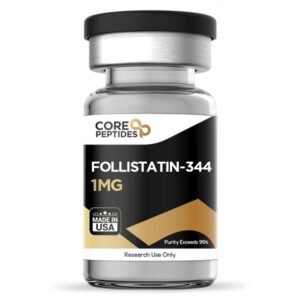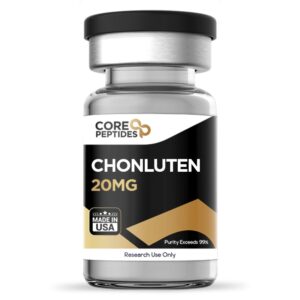Description
Selank Peptide – Synthetic Tuftsin Analog for Research Use
Molecular Formula: C₃₃H₅₇N₁₁O₉
Molecular Weight: 751.88 g/mol
Other Names: TP-7, Selanc
Form: Lyophilized Powder
Purity: >99% (HPLC)
Storage: -20°C (Dry, light-protected environment)
Research Use Only – Not for Human Consumption
Description
Selank peptide is a synthetic heptapeptide (seven-amino acid chain) developed as a structural analog of Tuftsin, a naturally occurring immunomodulatory tetrapeptide fragment derived from immunoglobulin G (IgG). Tuftsin is known for its role in regulating immune functions such as phagocytosis, cellular motility, and macrophage activation.
To enhance stability and broaden its potential biological activity, researchers synthesized Selank as an advanced analog by adding a Pro-Gly-Pro (PGP) tripeptide sequence to the C-terminal end of Tuftsin. This PGP modification may increase Selank’s ability to cross biological membranes, particularly the blood–brain barrier (BBB), by improving lipophilicity and facilitating receptor-mediated or endocytotic transport across the BBB. These adaptations make Selank an attractive compound for neuroscientific and immunological research, where stability and brain bioavailability are essential.
Overview and Mechanism of Action
Selank combines Tuftsin’s immunomodulatory effects with the potential neuroactive and nootropic actions of the PGP fragment. This dual mechanism allows Selank to interact with neurotransmitter systems, gene expression pathways, and immune modulation processes.
Researchers propose that Selank may influence serotonin and GABAergic signaling, regulate brain-derived neurotrophic factor (BDNF) expression, and affect genomic responses linked to inflammation and neuronal plasticity.
Chemical and Structural Insights
The presence of the Pro-Gly-Pro (PGP) sequence significantly alters Selank’s tertiary conformation, enhancing its resistance to enzymatic degradation and potentially increasing its bioavailability. The sequence also appears to improve molecular stability within biological fluids, thereby extending its research half-life and functional potential in neural environments.
Research Studies and Findings
1. Selank and BDNF Expression
Studies suggest Selank may enhance the expression of brain-derived neurotrophic factor (BDNF)—a vital protein involved in neuronal growth, synaptic plasticity, and cognitive resilience. In rodent models, increased BDNF mRNA levels were observed in the hippocampus, particularly under stress conditions where natural BDNF levels typically decline. These findings imply Selank may help counteract stress-induced reductions in neuroplasticity. (Inozemtseva et al., 2008)
2. Selank and Serotonin Pathways
Experimental evidence indicates that Selank may modulate serotonin metabolism, especially in cases where serotonergic signaling is impaired. The peptide appeared to enhance serotonin processing within brainstem regions associated with mood and anxiety regulation, suggesting a potential pathway through which Selank influences emotional stability and stress adaptation.
3. Selank and GABAergic Modulation
Selank has been shown to interact with the GABA (gamma-aminobutyric acid) system—the brain’s principal inhibitory network. Comparative studies between GABA and Selank revealed correlated changes in the expression of over 80 neurotransmission-related genes. Researchers propose that Selank may act as an allosteric modulator of GABA receptors, potentially contributing to anxiolytic and calming effects observed in preclinical models. (Volkova et al., 2016; Filatova et al., 2017)
4. Selank and Gene Expression in the Immune System
Genomic analyses in rodent models indicate Selank may regulate the expression of inflammatory genes, notably CX3CR1, within the spleen and hippocampus. This suggests the peptide could play a role in immune system balance and neuroimmune communication. (Kolomin et al., 2009)
5. Selank and Enkephalin Signaling
In human models of generalized anxiety disorder (GAD), Selank appeared to normalize enkephalin levels—endogenous opioids involved in mood, pain, and stress response—by inhibiting their enzymatic degradation. Results indicated anxiolytic effects comparable to traditional benzodiazepines, without their sedative drawbacks. (Zozulia et al., 2008)
6. Cognitive and Memory Enhancement
In animal learning experiments using conditioned avoidance response (CAR) testing, Selank exposure correlated with fewer learning errors and improved task recall. Researchers suggest these improvements may stem from Selank’s potential effects on neurotransmitter regulation, synaptic strength, and neural plasticity, underscoring its interest as a nootropic research compound. (Kozlovskii & Danchev, 2003)
7. Immunomodulatory Potential
Clinical studies revealed Selank may influence cytokine balance, including elevations in IL-6 and modulations in Th1/Th2 ratios, reflecting its role in immune system regulation. (Uchakina et al., 2008)
8. Withdrawal and Stress Response
In ethanol withdrawal models, Selank exposure reduced anxiety behaviors and mitigated withdrawal symptoms, suggesting possible benefits in regulating stress-adaptive neurotransmission. (Kolik et al., 2014)
9. Cardiovascular and Metabolic Effects
In feline and rodent models, Selank appeared to lower arterial blood pressure and enhance cerebral blood flow, while improving lipid metabolism and glucose regulation. Research also indicated decreased LDL, VLDL, and triglyceride levels, suggesting possible hypolipidemic and metabolic-modulating properties. (Gan’shina et al., 2005; Mjasoedov et al., 2014)
Summary
Selank peptide has demonstrated a multifunctional profile in research models—spanning neuroprotection, cognition, stress resilience, and immune modulation. Through its combined effects on GABAergic, serotonergic, and enkephalinergic systems, Selank remains a prominent candidate for neuropeptide research exploring novel anxiolytic, cognitive, and metabolic pathways.
References
-
Inozemtseva LS et al. Doklady Biological Sciences (2008) 421:241–243.
-
Najjar VA. Ann N Y Acad Sci. 1983;419:1–11.
-
Semenova TP et al. Eksperimental’naia i klinicheskaia farmakologiia, 2009.
-
Fridkin M et al. Biochim Biophys Acta. 1977;496(1):203–11.
-
Kozlovskaya MM et al. Neurosci Behav Physiol. 2003;33(9):853–60.
-
Filatova E et al. Front Pharmacol. 2017;8:89.
-
Volkova A et al. Front Pharmacol. 2016;7:31.
-
Kolomin TA et al. J Mol Neurosci. 2009;41(2):248–256.
-
Zozulia AA et al. Zh Nevrol Psikhiatr Im S S Korsakova. 2008;108(4):38–48.
-
Medvedev VE et al. Zh Nevrol Psikhiatr Im S S Korsakova. 2014;114(7):17–22.
-
Kozlovskii II & Danchev ND. Neurosci Behav Physiol. 2003;33(7):639–43.
-
Uchakina ON et al. Zh Nevrol Psikhiatr Im S S Korsakova. 2008;108(5):71–5.
-
Kolik LG et al. Bull Exp Biol Med. 2014;157(1):52–5.
-
Gan’shina TS et al. Eksp Klin Farmakol. 2005;68(4):33–5.
-
Mjasoedov NF et al. Exp Metab Syndr Study. 2014.





Reviews
There are no reviews yet.